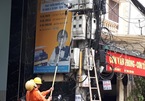Supply sources
Power plants in Vietnam belong to different owners. EVN (Electricity of Vietnam) holding company runs large plants such as Song Da, Son La, Ialy, Tuyen Quang, Tri An Hydropower and Vinh Tan 4 Thermopower.

The Hoa Binh Hydropower Plant
EVN’s subsidiaries specializing in producing electricity include GENCO 1, 2, 3, Thu Duc Thermopower and Thuan Binh Wind Power. Of these, only GENCO 3 has been equitized, while the remaining companies are single-member limited companies.
Besides EVN, PetroVietnam, Vinacomin and others also generate electricity. About 2 percent of electricity consumed is from imports.
The electricity daily consumption is 0.6 billion kwh, or 220 billion kwh a year. The electricity generation installed capacity is 0,6 billion kWh/24h = 25 triệu kW (25.000 MW). Son La Hydropower Plant has the capacity of 2,400 MW, while Hoa Binh 1,920 MW.
However, the real electricity generation capacity is just a little higher than 50 percent of the installed capacity. Son La provides 10.2 billion kwh a year, while Hoa Binh 8.2 billion. Meanwhile, Phu My Thermopower, the largest in the country, can provide 17 billion kwh.
If Vietnam wants to increase the electricity output by 10 billion kwh, or 5 percent, a year, it needs to build one more hydropower plant as the same size as Son La, or Hoa Binh, or it needs to build one more Phu My every two years.
| If Vietnam wants to increase the electricity output by 10 billion kwh, or 5 percent, a year, it needs to build one more hydropower plant as the same size as Son La, or Hoa Binh, or it needs to build one more Phu My every two years. |
The current investment rate is VND25 billion per MW of installed capacity of hydraulic power and VND50 billion per MW of real generation capacity. The figure would be higher for thermal power, about $2 million per kwh.
Who will spend money to build one hydropower plant like Son La every year, which costs VND60 trillion, or $2.5 billion?
With electricity generation sources with plentiful owners and short supply, this is enough for the power generation market to form. GENCO 3 has been equitized, and GENCO 1, 2 and other companies also need to become joint stock companies. The plants belonging to EVN Holding also need to be separated into independent plants, and restructured into joint stock companies, together with PetroVIetnam and Vinacomin’s plants.
EVN has stockholder equity of VND200 trillion, which is just enough for 20 percent of the total electricity demand. It now borrows VND400 trillion, and if the interest rate is 6 percent per annum, it would have to pay VND24 trillion in interest a year. And if it paid the principal within 10 years, it would pay VND40 trillion a year.
Towards a competitive distribution market
The distribution is being undertaken by power companies. Two thirds of the electricity output is reserved for the production sector. However, there is no big problem with the consumers. The electricity price in Vietnam is competitive, and enterprises benefit when they use more electricity. There is no reason to complain about the centralized management.
Problems only exist in the household-use sector. Consumers complain as they have to pay more in summer in accordance with the multi-tiered price mechanism. The Ministry of Industry and Trade (MOIT) designed a single pricing mechanism, but has withdrawn the solution as it was not applauded.
Consumers believe that the electricity price is unreasonable because EVN is enjoying a monopoly in distribution. EVN is a state-owned enterprise which has a lot of problems characterized for state-owned enterprises.
EVN’s subsidiaries need to switch to joint stock companies, and especially public companies to have higher transparency. By that time, many electricity users can be both clients and shareholders of power supply companies.
Maintaining the transmission system
Power companies buy electricity from electricity generation plants and sell electricity to consumers through the transmission system. The transmission is implemented by EVNNPT (Vietnam National Power Transmission Corporation), a 100 percent EVN invested corporation.
If considering the importance and role of the transmission company, which needs to ensure electricity security and electricity system safety, EVNNPT is not going to be equotized.
However, there should be a reasonable financial mechanism for EVNNPT. It needs to be given the right to negotiate with every buyer and seller about transmission prices.
The possibility of equitizing EVN
The operation model of EVN is quite cumbersome. It would be better for EVN to be divided into three large companies in charge of power generation, transmission and distribution.
If so, the role of the State would be setting reasonable policies to satisfy the demand for power and settle problems of social security, but it would not intervene in electricity pricing. In the future, many power generation plants won’t belong to EVN.
Ngo Van Tuyen

Experts suggest adjusting electricity retail price once every six months
Electricity consumers complain that retail electricity prices keep increasing.

Electricity Regulatory Authority rethinks single pricing model
The Electricity Regulatory Authority (ERA) has changed the proposal of allowing household consumers to choose to pay electricity bills under either a multi-tiered price or single-price mechanism.